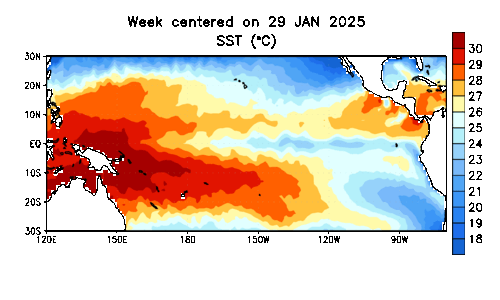 This image released by NOAA’s Environmental Visualization Laboratory shows the anomaly of sea surface temperatures in the Pacific Ocean. In this case, the red shading shows temperatures warmer than normally would be expected. The large region in the center is the primary focus of El Nino, along the equator. While there is currently a positive or warm phase of the Pacific Decadal Oscillation, I should point out that the 1997 view was in November, while the 2015 view is in July. There is a larger region in the north Pacific that appears to be above normal now. That could be a function of the season, so a more fair ENSO comparison will come this November. But the Climate Prediction Center should have a their hands full over the few seasons as more extreme weather is likely. That is not hype, but merely what El Nino’s have done in the US before.
This image released by NOAA’s Environmental Visualization Laboratory shows the anomaly of sea surface temperatures in the Pacific Ocean. In this case, the red shading shows temperatures warmer than normally would be expected. The large region in the center is the primary focus of El Nino, along the equator. While there is currently a positive or warm phase of the Pacific Decadal Oscillation, I should point out that the 1997 view was in November, while the 2015 view is in July. There is a larger region in the north Pacific that appears to be above normal now. That could be a function of the season, so a more fair ENSO comparison will come this November. But the Climate Prediction Center should have a their hands full over the few seasons as more extreme weather is likely. That is not hype, but merely what El Nino’s have done in the US before.
Warmer Global Temperature
The latest NOAA forecast shows a 90% chance this lasts through Fall, and 80% chance it extends into winter 2016. It is too soon to say for sure that this will be the strongest on record, but it is heading in that direction. The heat released from the largest ocean on Earth is likely this will push global temperature measurements for 2015 as one of the highest recorded. That is what happened in 1998.
Latest 10 week Sea Surface Temperature measurement animation:
- Sea Surface Temperatures
Seasonal Forecasts
The diminished tropical action was expected and built into tropical seasonal forecast expected to be above normal in the Pacific but quieter than normal in the Atlantic. There is a connection to ‘winter’ weather in the US. Most likely California will continue to get large rain storms. This should break the drought, but mudslides in fire scared hills will be the next threat. I will follow up with more on that shortly.
Normal Expectations:
A pattern of warm water the develops every three to seven years in the tropical Pacific along the equator. See more images in the slide show (below the video). The net expected global result:
- Shift of storm development away from Asia towards the central Pacific.
- Shifts the winds from normal light easterlies to westerlies at the surface.
- That adjusts the water currents and weather patterns across the entire Pacific.
- More active tropical season and stronger storms (as already seen in Asia).
- More storms, especially in winter reached the west coast of the US. Again, this can bring drought busting rain to California, but also flooding and mudslides.
- It also increases the westerly winds aloft in the tropical Atlantic. That is opposite the normal flow and cuts the top off of developing systems. This limits the number of tropical storms and hurricanes. However, 1992 was an El Nino year that also brought Hurricane Andrew to south Florida. Once can overcome the pattern and take on a life of its own.
- Southern US and Mid Atlantic regions tend to get a more active storm track from fall to winter. The positioning of other global patterns will determine where the cold air sets up and resulting snow and ice. It’s a little too early to call that.
Image below from NOAA
Expect Media Overload
Back in the 1990s, a media frenzy erupted, blaming everything on the event. I remember one report of a person in California listed as L. Nino in the phonebook receiving death threats. It was comical, and it would be wrong to skip the best El Nino video of all… Chris Farley:
El Nino Charts And Maps
.
[metaslider id=26859]Keep in touch via social media
- Facebook: Justin Berk, Meteorologist
- Twitter: @JustinWeather
- Instagram: justinweather
- Pinterest: justinweather
Get the award winning Kid Weather App I made with my oldest son and support our love for science, weather, technology. Our 2 year anniversary of the release is this November and it has been downloaded in 55 countries. With your support we can expand on the fun introduction to science and real weather:
SEVERE STORM SAFETY POSTS
- Lightning Safety: Tips, Pics, Video
- 5 Ways Lightning Strikes People
- Lightning Seen From Space: Red Sprites, Blue Jets, Elves
- Hail Safety: Best Improv Video
Stories you may have missed
Flooding in Ocean City: Second Day In A Row With Flooding Along Maryland And Delaware’s Coast
See the Video of the Flooding Whirlpool
Ocean City Storm: Lightning and rainbow pics, flooding video July 20
.
Shark Attack Fought Off At JBay Surf Tournament
.
Wind gust takes hot air ballon on destructive ride (video)
.
Waterspout Spotted Over Chesapeake By Bay Bridge (video)
.
15 Follow Up Photos Of Chesapeake Bay Waterspout July 17
.










